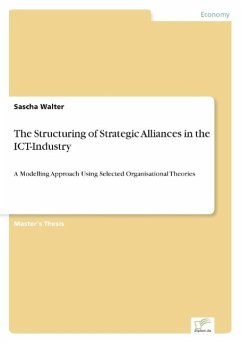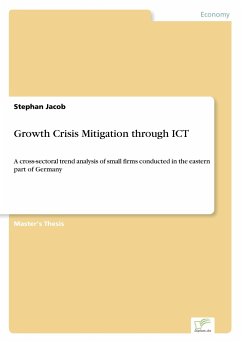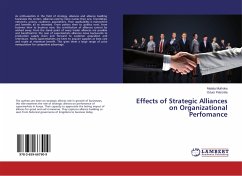Master's Thesis from the year 2002 in the subject Business economics - Personnel and Organisation, grade: 1,0, Bielefeld University (Wirtschaftswissenschaften), language: English, abstract: Inhaltsangabe:Summary:
This study examines what factors determine the choice of governance structure made by alliance partners in the ICT-industry. First, the explanatory power of the transaction cost theory, the resource-based view, the structural contingency approach, strategic choice theory, resource dependence theory, organisational ecology and principal agent theory to answer this question is surveyed.
A deeper analysis using transaction cost theory, resource-based view and structural contingency approach is employed to develop three models of alliance structuring. Propositions related to the models are then tested on a sample of 101 strategic alliances in the ICT-industry. The findings suggest that there exist five influential factors: (1) the existence of alliance-specific investment by the partners, (2) the number of functional areas contained by the alliance, (3) a limited duration of the alliance, (4) the type of resources contributed by the partners, and (5) uncertainty of the tasks of the alliance. These factors are then recombined to form one integrated model. The success of this approach and the usefulness of such a modelling approach in general are discussed alongside future directions for research.
Inhaltsverzeichnis:Table of Contents:
1.INTRODUCTION1
2.THEORETICAL BACKGROUND AND PREVIOUS WORK4
2.1Approach to Construct the Theoretical Framework4
2.2Definitions of Strategic Alliances5
2.3Classifications of Strategic Alliances6
2.4Review of Previous Work9
2.5Review of Theoretical Approaches13
2.6Theoretical Framework and Propositions for this Study24
3.METHODOLOGY33
3.1Objective of the Survey33
3.2Unit of Analysis33
3.3Methods of Data Collection34
3.4Methods of Analysis39
4.RESULTS45
4.1Findings of Univariate Analysis45
4.2Findings of Bivariate Analysis46
4.3Findings of Multivariate Analysis51
5.DISCUSSION57
5.1Position of the Sample57
5.2Factors of the Governance Choice57
5.3The Explanatory Power of an Integrated Approach63
5.4Contributions and Implications66
6.CONCLUSIONS70
7.REFERENCES72
8.APPENDICES83
Hinweis: Dieser Artikel kann nur an eine deutsche Lieferadresse ausgeliefert werden.
This study examines what factors determine the choice of governance structure made by alliance partners in the ICT-industry. First, the explanatory power of the transaction cost theory, the resource-based view, the structural contingency approach, strategic choice theory, resource dependence theory, organisational ecology and principal agent theory to answer this question is surveyed.
A deeper analysis using transaction cost theory, resource-based view and structural contingency approach is employed to develop three models of alliance structuring. Propositions related to the models are then tested on a sample of 101 strategic alliances in the ICT-industry. The findings suggest that there exist five influential factors: (1) the existence of alliance-specific investment by the partners, (2) the number of functional areas contained by the alliance, (3) a limited duration of the alliance, (4) the type of resources contributed by the partners, and (5) uncertainty of the tasks of the alliance. These factors are then recombined to form one integrated model. The success of this approach and the usefulness of such a modelling approach in general are discussed alongside future directions for research.
Inhaltsverzeichnis:Table of Contents:
1.INTRODUCTION1
2.THEORETICAL BACKGROUND AND PREVIOUS WORK4
2.1Approach to Construct the Theoretical Framework4
2.2Definitions of Strategic Alliances5
2.3Classifications of Strategic Alliances6
2.4Review of Previous Work9
2.5Review of Theoretical Approaches13
2.6Theoretical Framework and Propositions for this Study24
3.METHODOLOGY33
3.1Objective of the Survey33
3.2Unit of Analysis33
3.3Methods of Data Collection34
3.4Methods of Analysis39
4.RESULTS45
4.1Findings of Univariate Analysis45
4.2Findings of Bivariate Analysis46
4.3Findings of Multivariate Analysis51
5.DISCUSSION57
5.1Position of the Sample57
5.2Factors of the Governance Choice57
5.3The Explanatory Power of an Integrated Approach63
5.4Contributions and Implications66
6.CONCLUSIONS70
7.REFERENCES72
8.APPENDICES83
Hinweis: Dieser Artikel kann nur an eine deutsche Lieferadresse ausgeliefert werden.








